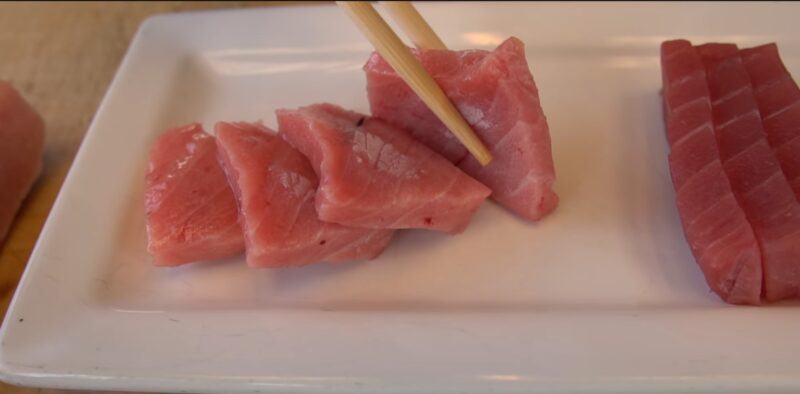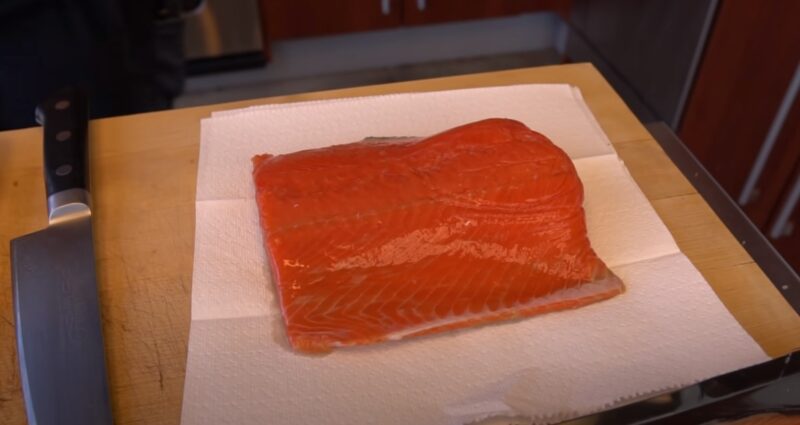When it comes to preserving the freshness and quality of raw tuna, understanding the proper storage techniques is crucial. The refrigerator is a common household appliance used to extend the shelf life of many perishable foods, including this one.
However, the duration that raw meat remains fresh in the fridge can vary based on several factors. In most cases, it will remain fresh for a day or two, but there are ways to keep it good for a longer time as well.
What is Affecting the Freshness?

The best way to prevent issues and avoid a situation where you will have to throw away the fish is to learn more about the main factors that affect its fresh state.
Source and Freshness at Time of Purchase
- Initial Quality: The shelf life in your fridge starts with its initial quality at the time of purchase. Tuna that has been freshly caught and properly handled will last longer than the one that has already spent several days in a retail display case.
- Handling and Processing: The way fish is handled and processed before it reaches your fridge also impacts its longevity. Tuna that has been exposed to higher temperatures or improper handling may spoil more quickly.
Refrigeration Temperature
- Consistent Cooling: The temperature of your refrigerator should be consistently at or below 40°F (4°C). Fluctuations in temperature can accelerate spoilage and reduce the time it can be safely consumed.
- Placement in the Fridge: Where you place the tuna in the fridge can affect its temperature. The back of the lower shelves is typically the coldest area, making it the ideal spot for storing raw tuna.
How to Recognize Spoiled Fish?

It’s essential to be able to identify when raw meat is no longer safe to eat. Spoilage can occur due to bacterial growth or chemical changes within the fish.
Appearance and Texture
- Color Changes: Fresh tuna typically has a bright red or pink color. A dull color or a brownish hue often indicates spoilage.
- Texture: It should be firm to the touch. If the flesh becomes mushy or slimy, it’s a sign that the meat has gone bad.
Other Indicators
- Odor: Raw tuna should have a clean, briny smell. An off-putting or ammonia-like odor is a clear sign that the tuna is spoiled and should not be consumed.
| Indicator | Good Quality | Potential Spoilage |
|---|---|---|
| Color | Bright red or pink | Dull, brownish |
| Texture | Firm | Mushy, slimy |
| Smell | Clean, briny | Off-putting, ammonia-like |
Best Options for Storing
To maximize the shelf life in your fridge, follow these best practices:
Immediate Refrigeration
- Timeframe: Place it in the fridge as soon as possible after purchase. Limit the time it spends at room temperature to reduce the risk of bacterial growth.
Airtight Packaging
- Vacuum Sealing: If possible, vacuum seal the fish to minimize exposure to air, which can accelerate spoilage. The Chicken of The Sea can be stored in the same way as other types of meat when you are using this option.
- Wrapping: If vacuum sealing is not an option, wrap the tuna tightly in plastic wrap or aluminum foil before placing it in an airtight container.
Check out Shelf Life
- Duration: Typically, raw tuna can be stored in the fridge for 1-2 days. However, this can vary based on the factors discussed earlier.
- Labeling: Mark the purchase or packaging date on the tuna before refrigerating to keep track of how long it has been stored.
Can You Extend the Shelf Life?
While the refrigerator can keep raw tuna fresh for a short period, there are methods to extend its shelf life further. These methods can be particularly useful if you have purchased tuna in bulk or cannot consume it within the standard 1-2 day timeframe.
Freezing Raw Fish
- Preparation for Freezing: To freeze it, wrap it tightly in plastic wrap, aluminum foil, or place it in a vacuum-sealed bag. This helps prevent freezer burn and flavor loss.
- Thawing: When you’re ready to use, thaw it in the refrigerator for 12 to 24 hours. Avoid thawing at room temperature to reduce the risk of bacterial growth.
Marinating
- Acidic Environment: Marinating in an acidic solution, such as lemon juice or vinegar, can inhibit bacterial growth and extend its freshness for an additional day. However, this method will start to “cook” the fish, changing its texture and flavor, akin to ceviche.
Be Aware of Health Risks
Consuming spoiled meat can pose serious health risks due to the presence of bacteria and toxins that can cause foodborne illness.
Symptoms of Foodborne Illness
- Gastrointestinal Distress: Symptoms can include nausea, vomiting, diarrhea, and abdominal pain.
- Neurological Symptoms: In some cases, especially with histamine (scombroid) poisoning, symptoms can include flushing, headaches, and palpitations.
Preventative Measures
- Proper Hygiene: Always wash your hands before and after handling raw meat.
- Cross-Contamination: Use separate cutting boards and utensils for it to prevent cross-contamination with other foods.
Best Recipes
Raw tuna is a versatile ingredient in the culinary world, prized for its delicate texture and flavor. Here are some popular ways to enjoy it, along with tips for preparation.
Sushi and Sashimi

- Quality: For sushi and sashimi, use sashimi-grade tuna, which is handled and frozen to specific standards to ensure safety for raw consumption.
- Slicing: Use a sharp knife to cut clean, even slices that enhance the eating experience.
Tartare and Poke Bowls
- Dicing: For dishes like tartare and poke bowls, dice the tuna into uniform pieces to ensure even seasoning and texture.
- Seasoning: Combine with ingredients like soy sauce, sesame oil, and fresh herbs to complement the tuna’s flavor.
Sushi is one of the most popular recipes in the world. If you have fresh tuna in your fridge, it can be a perfect dinner. But before that, you must learn more about the recipe.
| Ingredient | Quantity | Preparation |
|---|---|---|
| Sushi Rice | 2 cups | Rinse rice until water runs clear, cook as per package instructions, then season with sushi vinegar. |
| Sashimi-grade Tuna | 8 oz | Slice into 1/4 inch thick pieces. |
| Nori (Seaweed Sheets) | 2 sheets | Cut into halves. |
| Sushi Vinegar | 3 tbsp | Mix with cooked rice. |
| Wasabi | To taste | Prepare a small amount for placing between the rice and fish. |
| Soy Sauce | For dipping | Serve in a small dish on the side. |
| Pickled Ginger | For garnish | Serve on the side for palate cleansing between bites. |
| Cucumber (optional) | 1 small | Julienne for additional filling, if desired. |
| Avocado (optional) | 1 small | Slice thinly for additional filling, if desired. |
Alternatives if Raw Meat is not a good Option
When it is no longer at its peak freshness for raw consumption like sushi or sashimi, but still safe to eat, cooking is a great alternative to make use of the fish without wasting it. Here are some cooked tuna dish alternatives that can be safely enjoyed if the meat is past its prime.
| Recipe | Ingredients | Preparation Method |
|---|---|---|
| Seared Steaks | Tuna steaks, salt, pepper, olive oil | Season steaks, sear on high heat for 1-2 minutes each side |
| Pasta | Pasta, garlic, olive oil, cherry tomatoes, olives, capers, tuna | Sauté garlic, tomatoes, add tuna, olives, capers, toss with pasta |
| Burgers | Ground tuna, breadcrumbs, egg, seasonings | Mix ingredients, form patties, pan-fry until cooked |
| Casserole | Noodles, cream of mushroom soup, peas, cheese, tuna | Combine ingredients, bake until bubbly |
| Grilled Fish | Tuna steaks, olive oil, lemon juice, herbs, spices | Marinate tuna, grill over medium heat to desired doneness |
| Stir-Fry | Bell peppers, onions, broccoli, soy sauce, tuna | Stir-fry vegetables, add tuna and cook until done |
| Curry | Coconut milk, curry paste, vegetables, tuna | Cook curry with vegetables, add tuna, simmer until cooked through |
FAQs
Can I refreeze raw tuna after it has been thawed in the refrigerator?
It is generally not recommended to refreeze raw tuna once it has been thawed, as this can affect its texture and flavor. However, if it was thawed in the refrigerator and has been handled properly, it can be safely refrozen within 1-2 days of thawing. Just be aware that the quality may deteriorate.
Is it safe to eat raw fish from a can?
Canned fish is cooked during the canning process, so it is not considered “raw” and is safe to eat straight from the can. However, it is not suitable for recipes that require fresh, raw tuna, like sushi or sashimi.
How long can I marinate raw tuna in the fridge before it becomes unsafe to eat?
Raw tuna should not be marinated for more than 24 hours in the refrigerator. Marinating for too long, especially in an acidic marinade, can start to “cook” the fish and break down its texture, making it mushy.
Can I use leftover tuna sushi for a cooked tuna recipe the next day?
If you have leftover tuna sushi that has been refrigerated promptly and stored properly, you can repurpose the tuna for a cooked recipe the next day. Ensure that the sushi was not left out at room temperature for more than 2 hours and that it is still within the 1-2 day freshness window when cooked.
The Bottom Line
To ensure the best experience when storing and consuming raw tuna, always prioritize freshness and safety.
- Buy tuna from reputable fishmongers or stores with high turnover rates to ensure the freshest catch.
- Refrigerate it as soon as possible after purchase, and consume it within the recommended timeframe.
- If in doubt, trust your senses.
